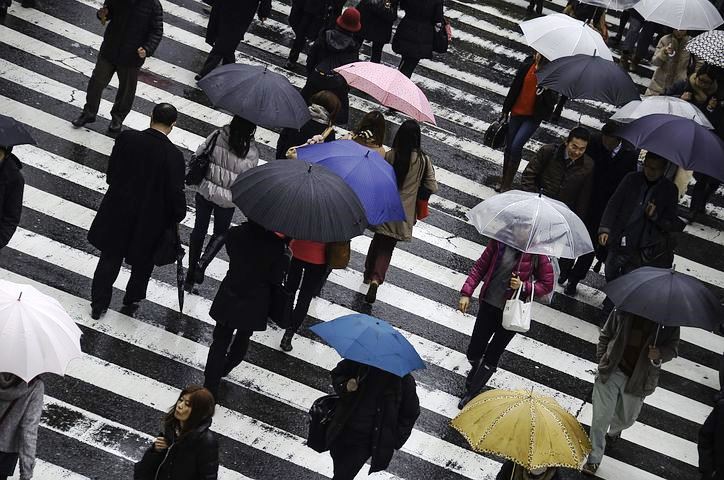 Ruchira traces the invention and antiquity of the umbrella, which is a must during the monsoon, in the weekly column. A Different Truths exclusive.
Ruchira traces the invention and antiquity of the umbrella, which is a must during the monsoon, in the weekly column. A Different Truths exclusive.
An umbrella is a ubiquitous but highly useful item in our daily lives. For a major part of its life this object is relegated to a remote corner of the home or perhaps that of a cupboard. Day in and day out it protects us from scorching sunlight and heavy downpours. But it demands nothing in return. It is low profile and largely maintenance-free. But have you ever wondered as to how this important accessory came into existence. For this, we need to delve into the history of human civilisation.
Origin
The origin of the umbrella is lost in the mists of time. Most likely it evolved from a primitive contraption of large fan-like leaves, fashioned by ancient men. As human society metamorphosed from family to tribe and from tribe to small kingdoms, the leafy device was transformed into a canopy like structure. As time passed by, it grew more and more colourful and ornamental. Still later it came to be regarded as a symbol of social prestige and hierarchy.
Etymology
The word umbrella evolved from the Latin umbella (originally a flat-topped rounded flower) or umbra, meaning shadow.The French and/ or Spanish world for umbrella is parasol – a combination of para, meaning to stop or to shield, and sol, meaning sun. Interestingly the French term “Parapluie” is a combination of para with pluie meaning rain. So it boils down to this: parasol and parapluie shield humans from sun and rain in that order.
Umbrella: In Ancient Civilisations
Since its basic purpose is to shelter humans form elements of nature ie sunshine and rainfall, quite naturally this safety device would make its debut in that part of the world where these factors are in abundance. That is to say coastal areas, tropical regions and overly warm climates. Well, exactly so. Parasols first appeared in ancient Egypt more than three thousand years ago. They were used to protect nobility and royalty from getting tanned or burned under the impact of the equatorial sun. Because these classes were a cut above the multitudes it was their monopoly to have lighter/ fairer skins. In ancient civilizations of the pre-Christian era – Mesopotamia, Persia, and China, to name few– the use of umbrellas was confined mainly to royalty and upper classes of society. They had multiple outdoor uses e.g., when the individuals walked or rode chariots to travel from one place to another. Interestingly the individuals never carried the umbrellas themselves; there were many attendants to perform the task for them. Also since its inception, the umbrella was subjected to numerous changes, experiments and innovations. Notably, the Chinese in the 11th century B.C, improvised leather umbrellas which were highly water proof and afforded greater protection to the user.
Umbrella: In India
India being a largely tropical country, umbrellas in their myriad sizes and shapes have been a part and parcel of its lifestyle and cultural ethos. We find endless examples of umbrellas being used –both by upper classes and ordinary folks–in sacred texts and literature, besides paintings, temple architecture et al. According to certain ancient schools of art, (Indian & Pan Asian) the Buddha is depicted with an umbrella over his head. In fact there are copious references to chhatradhari/dharinis who functioned as umbrella- bearers for royalty, nobles, and aristocrats. With the passage of time, religious priests became the predominant class in society. To flaunt their prestige and prominence, they took to using umbrellas on a massive scale. Thanks to the initiative of the priest community, umbrellas made inroads into temples and came to occupy a distinct niche over the heads of the idols enshrined therein. Even to this day, ornate, colourful and bejeweled umbrellas are a sine quoi non for major temple ceremonies and processions.
Umbrella: In Europe
It is likely that umbrellas reached Greece and Rome via Egypt. They were virtually monopolized women of higher classes of society. The fall of the Roman Empire was instrumental in uprooting this practice. Adverse circumstances, political turmoil and upheavals et al led to the disappearance of fancy umbrellas from the continent for several centuries. It was only in the post-Renaissance period that they staged a comeback. Possibly this revival was impacted by cultural currents from Asian lands since major trade routes had brought the two continents closer, In the subsequent centuries umbrellas became an inseparable  part of European women’s attire, a token of sophistication and vanity. Their male counterparts considered it beneath their dignity to use the feminine product and were contented to brave the sun and rain with the help of oilskin hats coats and boots. In France, the parapluie became commonplace in the 1660s, when the parasols began to be coated with wax. A Paris-based merchant, Jean Marius, introduced the first lightweight folding umbrella, in 1710. It could be opened and closed like modern umbrellas, and weighed less than a kilogram. The French monarch granted him an exclusive right to manufacture folding umbrellas on a wider scale. In 1759, Navarre, a French scientist made ample use of came to come up with a new design for the umbrella. It could now be opened by pressing a tiny button on the side of the cane. In England, during the 1750s, Jonas Hanway, a traveler-turned-founder of the Magdalene Hospital, who walked around in public with an umbrella was mercilessly jeered and booed by the commoners. Interestingly, in 1830, England’s first ever umbrella shop, James Smith & Sons was established.
part of European women’s attire, a token of sophistication and vanity. Their male counterparts considered it beneath their dignity to use the feminine product and were contented to brave the sun and rain with the help of oilskin hats coats and boots. In France, the parapluie became commonplace in the 1660s, when the parasols began to be coated with wax. A Paris-based merchant, Jean Marius, introduced the first lightweight folding umbrella, in 1710. It could be opened and closed like modern umbrellas, and weighed less than a kilogram. The French monarch granted him an exclusive right to manufacture folding umbrellas on a wider scale. In 1759, Navarre, a French scientist made ample use of came to come up with a new design for the umbrella. It could now be opened by pressing a tiny button on the side of the cane. In England, during the 1750s, Jonas Hanway, a traveler-turned-founder of the Magdalene Hospital, who walked around in public with an umbrella was mercilessly jeered and booed by the commoners. Interestingly, in 1830, England’s first ever umbrella shop, James Smith & Sons was established.
Meanwhile, changes and innovations continued in full swing. In 1852, Samuel Fox invented steel ribbed umbrella frames to replace the original wooden and whalebone ones. In 1928, Hans Haupt dished up a foldable pocket umbrella. Decades later, in 1969, Bradford E Phillips patented what is known as the ‘working folding umbrella’. New features and changes are ceaselessly being incorporated. The umbrella fabric now included plastic and reinforced material; it has grown transparent, floral, dotted with cartoon characters and what have you. However the characteristic J shaped handle (resembling a shepherd’s crook) is rarely to be seen nowadays.
Talking of umbrellas, Neville Chamberlain the Conservative Party Prime Minister of Britain during 1937 to 1940 years was never seen in public without his trademark black umbrella. Globally, this earned him the sobriquet of “Umbrella Man.”

©Ruchira Adhikari Ghosh
Photos from the Internet
#SliceOfLife #Umbrella #OriginOfUmbrella #TheUseOfUmbrella #TupesOfUmbrella #HistoryOfUmbrella #RainOrShine #DifferentTruths






 By
By


 By
By